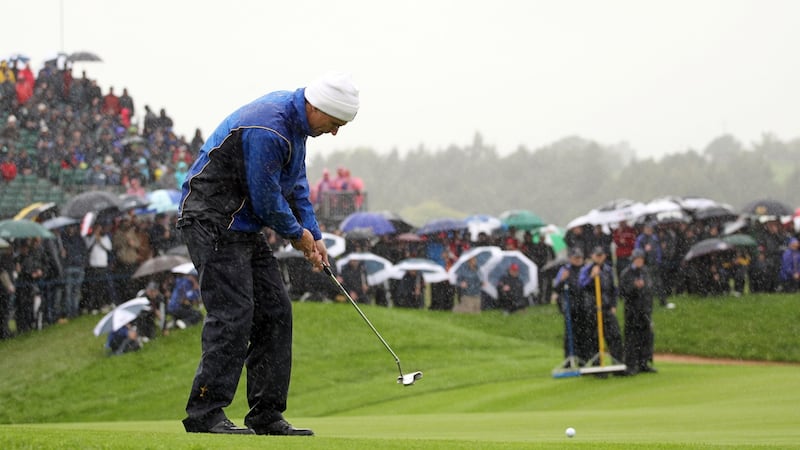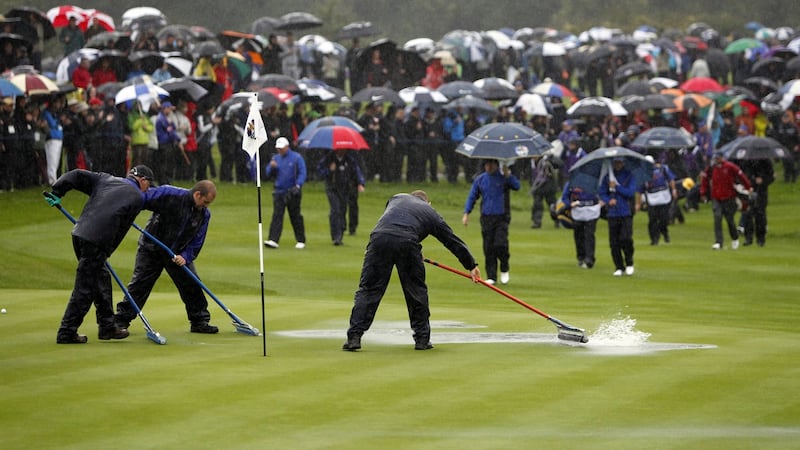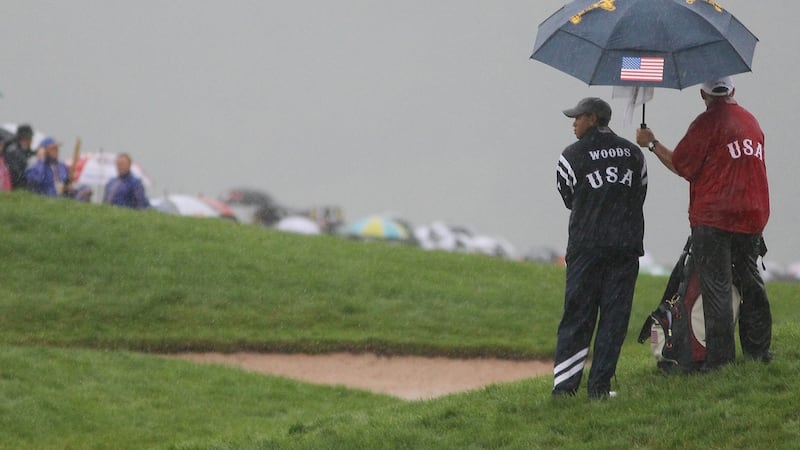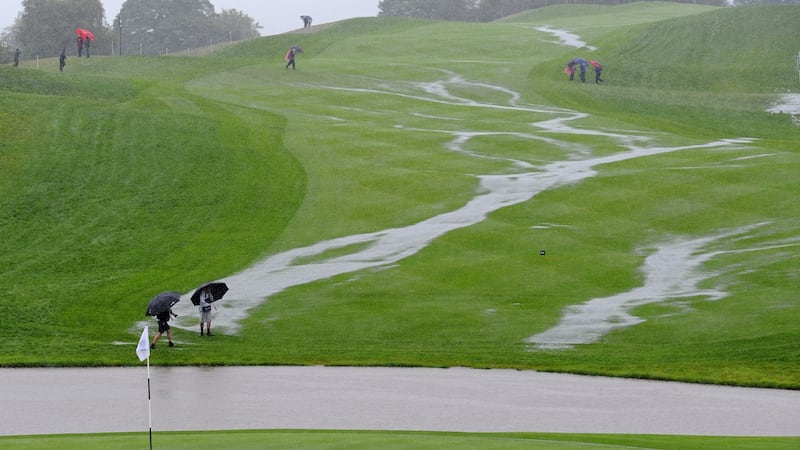The European Tour was back at Celtic Manor last week, I see. And, the Lord bless us and save us, this week too. No fans on-site because of all the unpleasantness, of course, which is fine and grand and obviously the correct call. But somewhere deep in the soul of anyone who endured the slog of the 2010 Ryder Cup, there will linger a suspicion that the pandemic is but a convenient excuse. Because if you were there, you’d find it hard to imagine why anyone would ever go back.
We were soaked to the arse at the back of the first green on the Friday morning when Pádraig Harrington nearly skittled both the squeegee guy and Steve Stricker with a shot he shouldn’t have hit from rough we couldn’t see. It was just before 9am on the first day and if there was a more miserable group of people at a sporting event anywhere in the world, it can only have been because there was some class of tragedy involved. This was not fun, not for anybody.

All around, the rain was falling like Poseidon’s revenge. Each of the four matches had been sent out onto the course with an army of squeegee operators riding shotgun. The greens were lakes, the fairways seas. Yardages were measured in nautical miles.
Colin Montgomerie, Europe’s captain for the week, was saying that if it was a normal European Tour strokeplay event, play wouldn’t have been considered. It felt like he was low-balling it. This was the sort of sideways rain that CNN would baulk at sending reporters out in, no matter how much weather disaster porn they sent back.
But this was also the Ryder Cup and, as would become ever clearer as we waded through the weekend, there was far too much money involved for it to be allowed to fall by the wayside. The lords of Celtic Manor had spent a bomb building the Twenty Ten course and you don’t do that without making sure it ignites. As far as the organisers were concerned, this was happening. Monsoon schmonsoon.
Batty format
I love the Ryder Cup. Always have. As a kid, I geeked out over the particulars of it more so than any event outside of maybe the football World Cup. Even now, every once in a while I’ll do some idle googling to see whatever became of Peter Baker or Steven Richardson or José María Cañizares, names that bubbled up in those Ryder Cups and really never again.
I love the slightly batty format, especially the alternate-shot foursomes. I remember bugging my dad into playing a foursomes match with me as a partner against my cousin and uncle one year, purely so we could have a Ryder Cup match. He had enough trouble taming his own game without having to put up with mine so we lasted about four holes before the cousin and I were politely told to play our own effing balls.
Most of all, I love a close Ryder Cup. I love that it starts at the C of the crack of dawn on a Friday morning and that every shot from there until Sunday afternoon is played like it’s the 72nd hole of a major. One-sided Ryder Cups are physics-lecture dull. But because 18-hole matchplay is a bit of a lottery, a squeaky bum classic is nearly always on the cards.
For seven Ryder Cups in a row between 1987 and 1999, there was never more than two points between the teams at the end. A two-point margin means that if just one match of the 28 had its result reversed, the whole thing would have been a draw. Think of the thousands of shots played across those seven Ryder Cups - you’re only talking a handful of putts here and there either dropping or not dropping for the record books to speak differently. Forget whether you’re into golf or not - if you’re into sport, you’re into close sport.
Celtic Manor was the third edition of the matches I had been to. The Belfry on 2002 was heart-stopping all the way along. The K Club in 2006 had been wet - not as bad as four years later in Wales but wet all the same. Europe had won both times and there were plenty of Irish storylines to report back. All in all, they were good gigs to cover.
On the face of it, 2010 should have been a similar story. The matches ended on a knife-edge, with Europe running out 14½ to 13½ winners. Not only that, but Graeme McDowell was the European hero, rounding off the best season of his life with the winning putt in the Ryder Cup to go along with his US Open victory. A close Ryder Cup with a prominent Irish angle - it ought to have been a dabba-do time all round.

Not so. First off, Celtic Manor was an awful choice of venue. Built in the Usk Valley near Newport, it’s a grand, stadium-style golf course with lots of high bank viewing areas and if there was a Ryder Cup there in the middle of the summer, you could throw down a picnic blanket somewhere like the bowl around the 17th green and be delighted with yourself. But you only had to walk around to it see that one thing it wasn’t designed for was a Ryder Cup in October in Wales.
Krypton Factor
It wasn’t the first Ryder Cup to get a bit of rain, it won’t be the last. But as the name implies, the Usk Valley is the kind of place you need to be in the full of your health to get around even when the sod is dry. Arriving in pitch darkness on the Friday morning with the rain battering the sides of the park-and-ride buses, anyone paying through the gates could see they had a Krypton Factor day ahead of them.
But if big time sport has taught us anything it’s that the sports fan will generally put up with a lot for the I-Was-There of it all. They will set the alarm for 4.30am in order to see the first tee shot three hours later. They will endure a bus carpark that is a Camino walk from the actual course. Most of all, they will pay through the nose for it.
Over the course of the week, from practice days to the extended finish on Monday, they had almost 250,000 visits to the course, made by just short of 118,000 people. Once inside, they squeezed them for every penny they could. A report compiled the following year said that close to £17m had been spent on food, drink and merchandise. The whole thing was a bare-faced racket.
If you wanted a radio to listen to the on-course commentary, it cost you £12. If you wanted an umbrella, it cost you four times that. If you wanted a wetsuit, you had to get in line - the American team was queueing up ahead of you. Or at least flunkies from the PGA were.
This was the Ryder Cup where the American team’s raingear had gone through every imaginable test ahead of time except the one that checks if they are actually waterproof. Designed by Lisa Pavin, wife of team captain Corey, they had each golfer’s name stitched across the back, like they were football players. Sadly, nobody had though to make sure that the stitching kept out water.

It did not, leading to a mad rush to the merchandise tent with the PGA of America credit card midway through the opening morning, there to drop four grand on the gammiest branded raingear you ever saw to kit out Team USA. Everyone thought it was hilarious. The players were less amused.
By this stage, play had been suspended. The teams had struggled through two hours of golf on that opening morning before crying enough. It had taken the opening group 36 minutes to play the first hole, a fairly straightforward 465-yard par four. It meant the other matches got stacked up behind them, leading to Harrington thinking the green was clear for his second, even as Stricker and Tiger Woods were lining up their putts. His ball scuttled through, whizzing past a bemused Stricker and a nearby squeegee lad who was already questioning his life choices.
This was the first post-scandal Ryder Cup for Tiger. He had, to much pointed muttering in the crowd, arrived at the opening ceremony on his own, the sole American player without a wife or girlfriend on his arm. The Welsh crowd tried to gin up a bit of mischief, giving it a lusty chorus of, ‘Elin is a Euro, Elin is a Euro, na-nah-nah-nah, na-nah-nah-nah.’ They were roundly shushed by the usual spoilsports and bores.
They got to just short of 10 o’clock before the hooter called everybody in. The course was sodden, the bunkers were starting to look like desert lakes and even with preferred lies, the players were having trouble finding anywhere to place their balls. It was long past time to call it.
Relentless
And so everyone went back to the tented village. For eight hours. It rained and it rained and all you could do was plonk yourself somewhere and crack open your wallet. They were pretty shameless about it too. On every screen, big and small, they actually had a ticker running along the bottom encouraging everyone to “Take shelter in the merchandising tents and restaurants.”
It was alright for us, the press tossers in our big tent with our free coffee and our subsidised cafeteria. But for anyone who was there as a punter, the sell was relentless. Here, how about some fish and chips? That’ll be 15 quid, thanks. There’s lots to do in the champagne tent, don’t forget. Have you been to the merch hangar yet? What, only three times? Sure you’ve barely scratched the surface.
The rain delay lasted seven hours and 18 minutes. Finally, at five o’clock, the players were back on the course. To put the tin lid on it all, the organisers very quickly issued a statement thanking everyone for their patience and making it clear that absolutely nobody was entitled to a refund. Just in case anyone got ideas.
Saturday was another grind and Sunday lost a full morning to even more rain. Literal rivers were flowing down from the hills and across the fairways, causing play to be delayed until lunchtime. It eventually all got played out and McDowell did his thing late on Monday afternoon to put it in the books. You could only have been delighted for him.

But by that stage, this was strictly TV fodder. The rain was one thing. You could live with the rain. The rapacious gouging of the suddenly captive audience was another matter altogether. The Ryder Cup is a magnificent event. But unless you’re playing in it or working at it, it’s best enjoyed on the couch.











